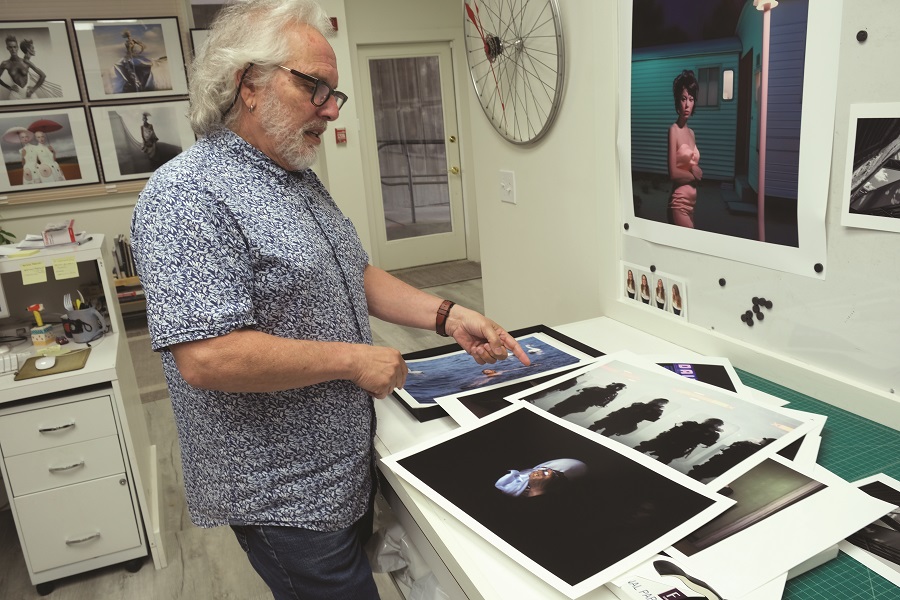EASTHAM — Bob Korn’s long career spans the seismic shift from analog to digital photography. But through seemingly endless changes in technology, he remains committed to the importance of the printed photograph and the craftsmanship that goes into creating one.
Early in the digital age, Korn worried that he might no longer have a career. “Do I start slicing deli meat?” he says he thought. “Fortunately, I found a job selling bikes one day a week. There were many lean years.

“The digital industry created this concept that one can buy a camera, a printer, and software, and anybody can create a print,” Korn continues. “Then it turned into this thing where it’s like, ‘What do I need a print for? It’s here on my phone.’ ” But at the end of the day, he says, “You’re not hanging your screen on a wall.”
“A photograph is not a photograph until it’s a print,” says Korn. “When you hold something in your hand, you become connected to it. And all electronics fail at some point. Prints will last over 100 years.”
The truth is Korn came to embrace the tools of the digital age so he could continue creating prints. “I hate technology,” he says, “but I’m forced to use it.”
In his Eastham print shop — after 43 years with a studio above the Orleans Whole Food store, Korn relocated to Eastham a year and a half ago — he is working on a black-and-white photograph of an industrial scene by Mark Thayer, a commercial photographer who is a former student.
Two test proofs hang on the wall. Thayer thought the initial print was too dark, so Korn is adjusting the image in Photoshop. As he works, he’s thinking about the darkroom processes that the software imitates. “One of the things that was difficult in a darkroom was creating contrast,” says Korn. “You could do this through different papers, different development, and by dodging to make something lighter and burning to make something darker.”
Despite Korn’s nostalgia for the darkroom, he seems to enjoy the ease of adjusting values with the drag of a mouse. The levels tool allows him to adjust the overall value or work with just the lights or just the darks. He also uses a mask to isolate the sky and adjust its value separately from the other elements in the image. “I can work on a specific area with greater refinement than I can in a darkroom,” says Korn. “But it’s still the same process.”
Korn is always thinking about light. “All photography is based on light and how you represent light,” he says. In Thayer’s photograph, he’s trying to bring out more information in the shadows and accurately depict a certain quality of light. “The light at two in the afternoon is much different than eight at night,” says Korn.
Flipping through a portfolio of work he has printed, Korn points to a photograph of two women in mourning in Mosul, Iraq by four-time Pulitzer Prize-winning photojournalist Carol Guzy. “When you look at a photograph, you want to feel like there’s no barrier between you and the print,” says Korn. “You know it’s right when you become part of that scene.”
The central figure in Guzy’s photo is a woman covering her face. Her white headscarf contrasts dramatically with the dark background — a visual move reminiscent of what one sees in a Caravaggio painting. To the right stands another woman, barely visible in the shadows. The light is exquisitely sensitive. Korn’s contribution to creating this print was both technical and poetic.
“I understand what this is all about,” says Korn. “I understand the emotion that comes forward with her as a shadow.”

Another photograph of light falling across a bayside porch is from Joel Meyerowitz’s series, Cape Light. “It’s his image, but my print,” says Korn.
He considers himself a collaborator with the photographers who work with him. “People come to me for what I can add to their work,” he says. He watermarks his exhibition prints with his signature and is sought after by top photographers. “I have work in every major collection,” says Korn.
He also says he has printed photographs for “anyone and everybody” and that his clients include people who want a print of a photo of their new puppy taken on an iPhone.
In light of Korn’s grudging acceptance of technology, it’s surprising to see an exhibition of his prints of AI-generated images by John Huet on the walls of the gallery at the front of his workshop.
“John told me about his idea and I said, ‘No way, I’m not doing it,’ ” says Korn. “I’m a traditionalist when it comes to photography.”
But he later came around, at least in this case. “We talked about it,” he says. And Huet’s background as a traditional photographer sealed the deal. “He understands light,” says Korn. Of Huet’s AI work, he says, “It’s still light and shadow.”
Despite the range of projects he takes on, there are some things Korn won’t do. “I’m not taking out telephone lines or the bush behind someone’s head,” says Korn. In this sense, he’s still a purist. “If you use software to add elements, remove elements, add a sky or something, it’s not a photograph. It’s a digital print.”
